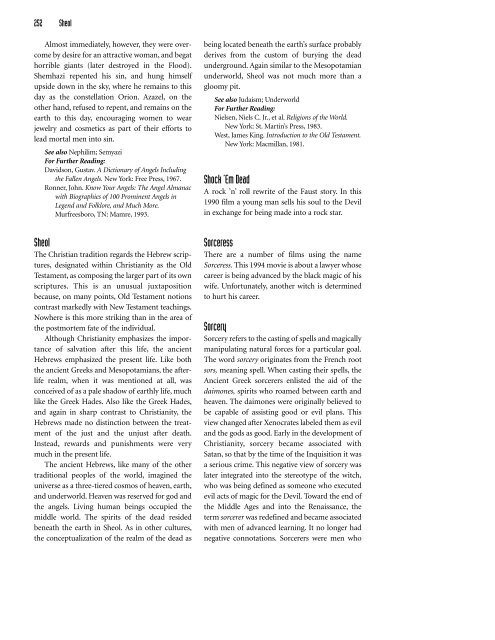Satanism Today - An Encyclopedia of Religion, Folklore and Popular ...
Satanism Today - An Encyclopedia of Religion, Folklore and Popular ...
Satanism Today - An Encyclopedia of Religion, Folklore and Popular ...
Create successful ePaper yourself
Turn your PDF publications into a flip-book with our unique Google optimized e-Paper software.
252 Sheol<br />
Almost immediately, however, they were overcome<br />
by desire for an attractive woman, <strong>and</strong> begat<br />
horrible giants (later destroyed in the Flood).<br />
Shemhazi repented his sin, <strong>and</strong> hung himself<br />
upside down in the sky, where he remains to this<br />
day as the constellation Orion. Azazel, on the<br />
other h<strong>and</strong>, refused to repent, <strong>and</strong> remains on the<br />
earth to this day, encouraging women to wear<br />
jewelry <strong>and</strong> cosmetics as part <strong>of</strong> their efforts to<br />
lead mortal men into sin.<br />
See also Nephilim; Semyazi<br />
For Further Reading:<br />
Davidson, Gustav. A Dictionary <strong>of</strong> <strong>An</strong>gels Including<br />
the Fallen <strong>An</strong>gels. New York: Free Press, 1967.<br />
Ronner, John. Know Your <strong>An</strong>gels: The <strong>An</strong>gel Almanac<br />
with Biographies <strong>of</strong> 100 Prominent <strong>An</strong>gels in<br />
Legend <strong>and</strong> <strong>Folklore</strong>, <strong>and</strong> Much More.<br />
Murfreesboro, TN: Mamre, 1993.<br />
being located beneath the earth’s surface probably<br />
derives from the custom <strong>of</strong> burying the dead<br />
underground. Again similar to the Mesopotamian<br />
underworld, Sheol was not much more than a<br />
gloomy pit.<br />
See also Judaism; Underworld<br />
For Further Reading:<br />
Nielsen, Niels C. Jr., et al. <strong>Religion</strong>s <strong>of</strong> the World.<br />
New York: St. Martin’s Press, 1983.<br />
West, James King. Introduction to the Old Testament.<br />
New York: Macmillan, 1981.<br />
Shock ‘Em Dead<br />
A rock ’n’ roll rewrite <strong>of</strong> the Faust story. In this<br />
1990 film a young man sells his soul to the Devil<br />
in exchange for being made into a rock star.<br />
Sheol<br />
The Christian tradition regards the Hebrew scriptures,<br />
designated within Christianity as the Old<br />
Testament, as composing the larger part <strong>of</strong> its own<br />
scriptures. This is an unusual juxtaposition<br />
because, on many points, Old Testament notions<br />
contrast markedly with New Testament teachings.<br />
Nowhere is this more striking than in the area <strong>of</strong><br />
the postmortem fate <strong>of</strong> the individual.<br />
Although Christianity emphasizes the importance<br />
<strong>of</strong> salvation after this life, the ancient<br />
Hebrews emphasized the present life. Like both<br />
the ancient Greeks <strong>and</strong> Mesopotamians, the afterlife<br />
realm, when it was mentioned at all, was<br />
conceived <strong>of</strong> as a pale shadow <strong>of</strong> earthly life, much<br />
like the Greek Hades. Also like the Greek Hades,<br />
<strong>and</strong> again in sharp contrast to Christianity, the<br />
Hebrews made no distinction between the treatment<br />
<strong>of</strong> the just <strong>and</strong> the unjust after death.<br />
Instead, rewards <strong>and</strong> punishments were very<br />
much in the present life.<br />
The ancient Hebrews, like many <strong>of</strong> the other<br />
traditional peoples <strong>of</strong> the world, imagined the<br />
universe as a three-tiered cosmos <strong>of</strong> heaven, earth,<br />
<strong>and</strong> underworld. Heaven was reserved for god <strong>and</strong><br />
the angels. Living human beings occupied the<br />
middle world. The spirits <strong>of</strong> the dead resided<br />
beneath the earth in Sheol. As in other cultures,<br />
the conceptualization <strong>of</strong> the realm <strong>of</strong> the dead as<br />
Sorceress<br />
There are a number <strong>of</strong> films using the name<br />
Sorceress. This 1994 movie is about a lawyer whose<br />
career is being advanced by the black magic <strong>of</strong> his<br />
wife. Unfortunately, another witch is determined<br />
to hurt his career.<br />
Sorcery<br />
Sorcery refers to the casting <strong>of</strong> spells <strong>and</strong> magically<br />
manipulating natural forces for a particular goal.<br />
The word sorcery originates from the French root<br />
sors, meaning spell. When casting their spells, the<br />
<strong>An</strong>cient Greek sorcerers enlisted the aid <strong>of</strong> the<br />
daimones, spirits who roamed between earth <strong>and</strong><br />
heaven. The daimones were originally believed to<br />
be capable <strong>of</strong> assisting good or evil plans. This<br />
view changed after Xenocrates labeled them as evil<br />
<strong>and</strong> the gods as good. Early in the development <strong>of</strong><br />
Christianity, sorcery became associated with<br />
Satan, so that by the time <strong>of</strong> the Inquisition it was<br />
a serious crime. This negative view <strong>of</strong> sorcery was<br />
later integrated into the stereotype <strong>of</strong> the witch,<br />
who was being defined as someone who executed<br />
evil acts <strong>of</strong> magic for the Devil. Toward the end <strong>of</strong><br />
the Middle Ages <strong>and</strong> into the Renaissance, the<br />
term sorcerer was redefined <strong>and</strong> became associated<br />
with men <strong>of</strong> advanced learning. It no longer had<br />
negative connotations. Sorcerers were men who
















